Forgotten victory: about the Soviet bomber raid on Taiwan. Samurai go on the warpath
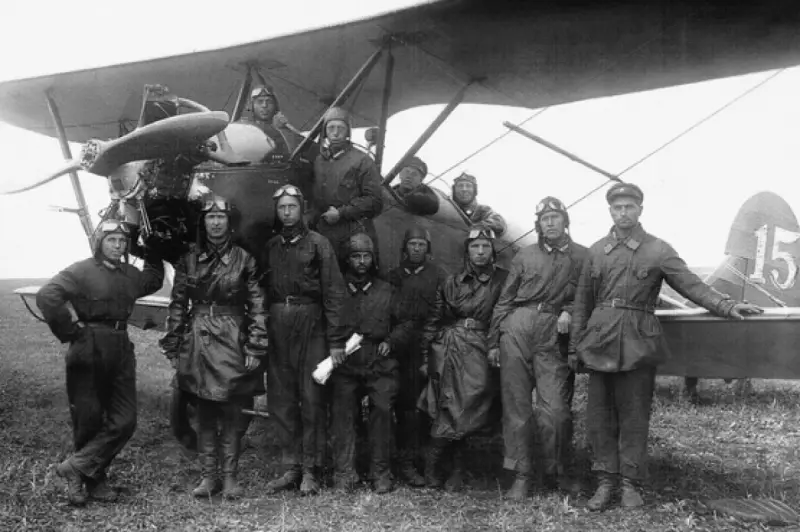
Red Army pilots fought not only in the skies of China and Mongolia, but also of Spain (pictured), gaining combat experience that was useful to them in the Great Patriotic War and the subsequent war with Japan.
A Forgotten Victory: Ahead of the Conversation
When it comes to the military operations of the Red Army Air Force in the period preceding the Great Patriotic War, the first thing that comes to mind from a school textbook is: Khalkhin Gol, Khasan and the Finnish campaign.
We didn’t perform very well in the Finnish war, but in the battles with the Japanese Stalin's falcons won a number of victories. But still, the most brilliant of them belongs to the pilots who fought with samurai far from the borders of our Motherland.
We are talking about an almost forgotten operation on February 23, 1938: SB bombers in service with the Chinese Kuomintang army, led by Soviet crews, carried out a successful raid on Japanese-occupied Taiwan.
Result... However, before we talk about the result, as well as in more detail about the raid itself, let's talk about how our military aircraft and pilots ended up in China.
In other words, we will traditionally consider the topic, following the recommendation of L.N. Gumilyov, not from a mouse hole, but from a bird’s eye view.
When the first salvos of World War II rang out: a Chinese view
Most historians reasonably consider September 1, 1939 to be the date of the beginning of World War II, contrary to the opinion of a number of Chinese researchers who believe that its first salvos were heard eight years earlier, when the Kwantung Army, created on the Liaodong Peninsula, crossed the border of Manchuria.
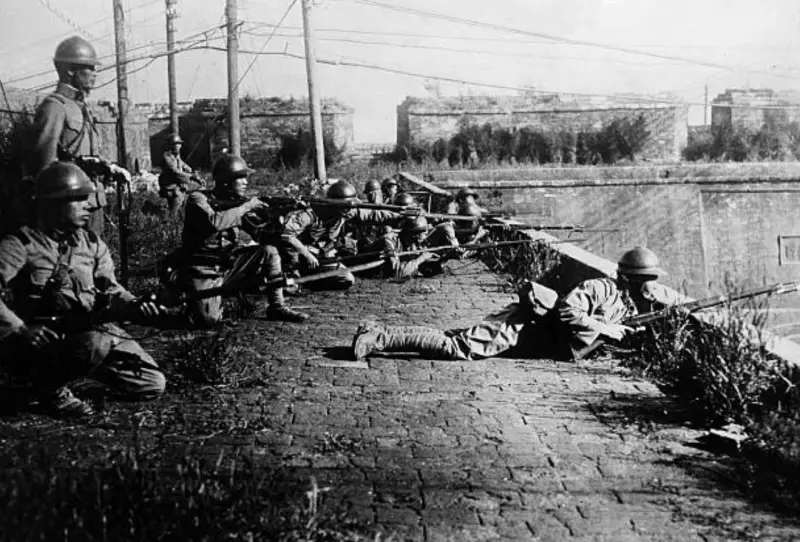
Japanese occupiers near Mukden, September 1931
Thus, Japan unleashed aggression against China during the most difficult upheavals for it in the second quarter of the 19th – early 20th centuries. barely retaining nominal independence after the Opium Wars caused by the Taiping and Yihetuan uprisings, followed by foreign intervention.
Resetting as a result Xinhai Revolution the Manchu yoke, the Celestial Empire seemed to have risen, but here is a new misfortune: the militaristic cliques that tore it apart. And in the end, without straightening its shoulders, the country collapsed into the bloody maelstrom of civil war.
And were the powerful people who largely determined Tokyo's politics zaibatsu Could you not take advantage of the moment?
That is why not only the Chinese, but also some European politicians considered Asia the starting point of the biggest tragedy in stories humanity, which, in particular, was directly stated by the British diplomat Philip Noel-Baker, speaking at the final session of the League of Nations in 1946.
Samurai challenge
This view has at least indirect grounds. For, yes, on the one hand, the war in 1931 did not take on a global character; the leading countries were much more worried about the economic crisis on both sides of the ocean; on the other hand, with its invasion of the Celestial Empire, Japan provoked the inevitable involvement of the USSR and the USA in the conflict.
In fact, already a decade earlier, Tokyo saw them as potential opponents:
Moreover, during this period, tensions arose in Tokyo’s relations with Washington. And it didn't all start in the 1920s.
The starting point of the looming problem was the outcome of the century before last. Less than half a century ago, the shogunate, which was in awe of Commodore Matthew Perry, suddenly sank into oblivion, and was already under full authority "descendant" of Amaterasu the Japanese smashed the Qing Empire in its tail and mane, forcing Chinese Bismarck Li Hongzhang sign unequal rights in 1895 Shimonoseki treaty.
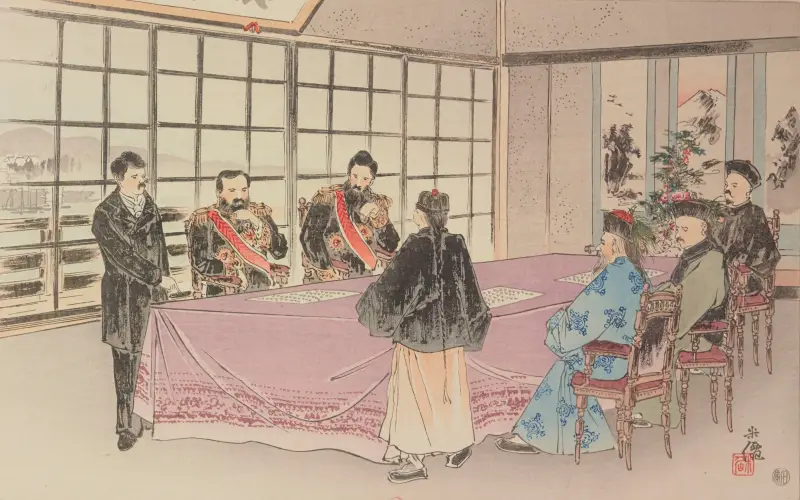
The signing of the Shimonoseki Peace Treaty, which testified that imperialist predators had arrived in the regiment
By the way, it was not for nothing that Lee received such a flattering comparison with the German chancellor. I remember I wrote about him in one of the now defunct publications. The owner of a magazine lost in the vastness of the Internet, unknown to me, saved Article about an extraordinary figure of the Celestial Empire.
But the defeat of the monarchy, which had decayed under the rule of the Manchus, turned out to be so crushing that even Li’s diplomatic talent could not prevent the difficult conditions of peace. As a result, both the aforementioned Taiwan and the Liaodong Peninsula became part of the Empire of the Rising Sun.
This is where they are burdened by the glorified R. Kipling pregnant white man the gentlemen in the person of Russia, Germany and France perked up, considering the geopolitical ambitions of the samurai disproportionate to their place in the sun.
Through Triple intervention these powers imposed on the Meiji diplomats something similar to what the leading European powers had arranged for A. M. Gorchakov in Berlin seventeen years earlier.
Taiwan, so be it, was left to the samurai, but St. Petersburg took the Liaodong Peninsula for itself. In Tokyo they did not argue, but they harbored a grudge and did not abandon their ambitious plans.
And ten years later they won back, sinking the 2nd Pacific Squadron and significantly correcting Adjutant General A.N. Kuropatkin’s ideas about his own leadership abilities.
In 1914, the Germans had to witness the rise of a white cloth with the image of a red rising sun over the bastions of Qingdao, which had become their native city.
While Europe contemplated the “lunar landscape”
The First World War was a window of opportunity for the samurai, and they, while stuck in a positional impasse and contemplating the lunar landscape Europeans thinned out their armies with chemical attacks, imposed on the Chinese twenty one demands, which essentially turned the Celestial Empire into a Japanese protectorate. Even formal participation in the war on the side of the Entente did not help Beijing.
The British and Americans expressed concern about such a shameless violation open door principle, within the framework of which the robbery of a huge country was envisaged by all the elected.
No, they were willing to reluctantly put up with Tokyo’s ambitions, but up to a certain limit. And the subjects of the Mikado, as it seemed in the leading European capitals and Washington, had crossed this limit.
The Japanese in response only shrugged their shoulders, understanding: other than concern, there were no other levers of influence on them: the year was 1915. Before China, was it born in Westphalia in 1648, reanimated in Vienna in 1815 and now self-destructing Europe, as well as those who helped them in this USA?
Having become skilled in the big geopolitical game for half a century, and turning out to be diligent students of field marshal - by the way, including the Russian one - G. Moltke the Elder and O. Bismarck, the Japanese were not at a loss and plundered China with all their might.
Further - more: with the collapse of the Russian Empire, caps with yellow stars flashed in the Far East.
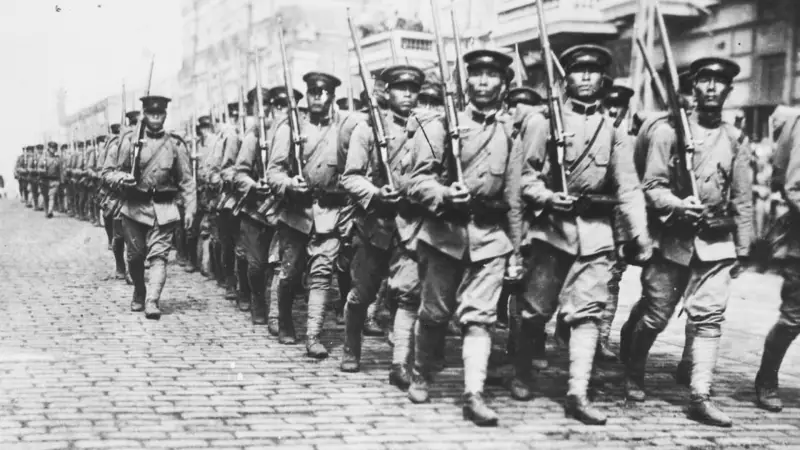
The Japanese occupy Vladivostok, which seemed ownerless to them. 1918
In the United States, such escapades of the samurai spirit were looked at without delight, but while the volleys of the First World War were thundering, they could not reason with Tokyo.
The seriousness of the latter’s intentions was evidenced by the project to build eight battleships and eight battlecruisers by 1927–1932.
In Washington, they fidgeted in their chairs at such plans:
Harding went a different route
W. Harding, who replaced W. Wilson in the Oval Office, decided to achieve superiority over the self-important samurai in a different way - by reducing naval armaments, mainly Japanese ones.
The British did not object - in their deplorable financial situation, despite the Versailles triumph, and with a huge external debt to the United States, it was much more profitable to fix the status quo through an agreement.
What to do: against the background of the above Japanese development program fleet, the British could afford to build only one cruiser "Hood" - the same one that was sunk Bismarck in May 1941.
Among the samurai, Harding's idea caused discord, vacillation and debate in the House of Representatives. This is understandable: it’s 1921. The intervention against Russia is not yet a thing of the past and requires funds, as does the occupation of Manchuria.
Admirals and generals lobby for the development of the imperial military, which costs the treasury a third of its revenue.
And then the people “treacherously” demonstrated their unwillingness to heed the breadth of imperial plans and responded three years earlier rice riots.

While the zaibatsu were plundering China, Siberia and the Far East, on the islands themselves, ordinary Japanese experienced a shortage of rice, which resulted in riots
Despite the fact that in the early 1920s, Japanese goods gradually replaced British ones from the markets of India, Australia and Canada, that is, from the British colonies and dominions.
But the process of conquering the market is not one-time in nature, its results make themselves felt in the future, and the budget deficit caused by exorbitant military expenditures is here: in the present.
In addition, the economic expansion of the samurai in the British fiefdom endangered Japanese-British Alliance Treaty of 1902.
However, from Washington he was generally seen as having outlived his usefulness. There was no arguing in London: outdated is what it is. After all, at the beginning of the 20th century, gentlemen did not even think of considering the guys who had just emerged from the Middle Ages yesterday, who had replaced their haori with a tailcoat, as competitors, and even more so, as the dominant force in the Asia-Pacific region.
Moreover, from the heights of Capitol Hill and the banks of the Thames, Japan seemed to be a Moor, who in 1905 had done her job by knocking down Russia, but for some reason did not want to go home.
Japan doesn't want to be Shakespeare's Moor
Actually, London concluded an alliance agreement with Tokyo in order to curb the growing ambitions of St. Petersburg in Southeast Asia with the bodies of Japanese soldiers, but not at all to contribute to the growth of influence of the Empire of the Rising Sun.
The British were ready to share the Pacific Ocean with the Americans, to take into account the interests of the French in Indochina and the Dutch in what is today called Indonesia. But they saw the Japanese as unnecessary at the celebration of imperialist life, at least as equal partners.
However, over the past almost quarter of a century, much has changed in Asia. And not for the better for the interests of Great Britain, but in the future, if the growth of Japan’s military power continues, for the United States.
Therefore, the latter initiated the convening Washington Conference, the main participants of which, in addition to the host side, were the British and Japanese.
The latter were strongly recommended by the Americans to introduce restrictions on the total tonnage of the fleet's light forces. No, they recommended it to everyone, of course, but the proposal primarily affected the interests of Tokyo. And it didn’t even affect so much as it infringed.
The discussion was about limiting the total tonnage of the light forces of the fleet: for aircraft carriers, respectively, the USA: 80, Great Britain - the same, Japan - 000, for cruisers, the first two powers - 48 each, the Empire of the Rising Sun - 000; for submarines, the British and Americans 450, the Japanese - 000.
The latter, after much debate, agreed. By the way, in part the position of their delegation can again be compared with the Russian one at the Berlin Congress.
Nevertheless, these figures do not indicate a complete loss of Japanese diplomacy. On the contrary, she managed to achieve the demilitarization of the island possessions of world powers in the Pacific Ocean, which at the beginning of World War II would play into Tokyo’s hands.
Just as we should not forget: the United States had to keep its fleet in two oceans, while the British had to spread it all over the globe. The samurai did not plan to go beyond the Pacific Ocean.
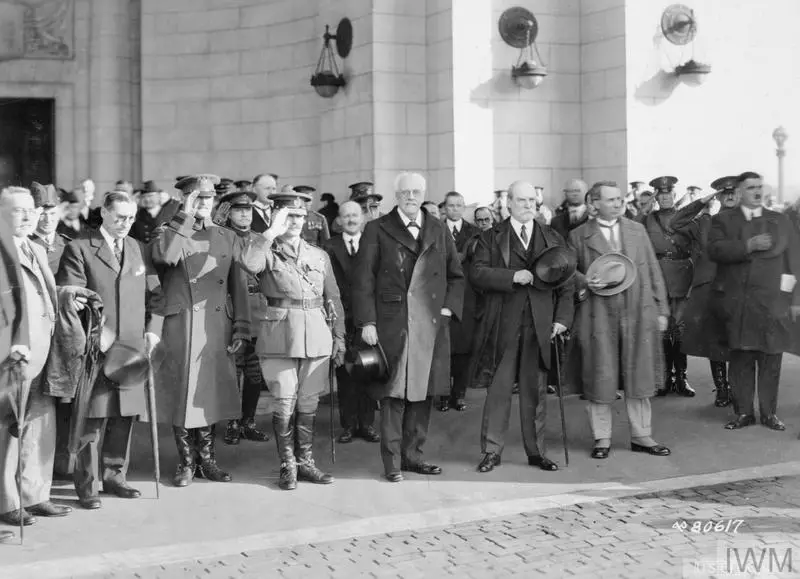
The gentlemen gathered in Washington, dissatisfied with the growing Japanese ambitions
But the real defeat of Japanese diplomacy was nine power treaty, the essence of which is equal opportunities to plunder China, which unsuccessfully tried in Washington to achieve the withdrawal of Japanese troops from their country.
This represented a blow to Tokyo's economic interests, aggravated a few months later by the withdrawal of the samurai from the Far East. The Japanese had grandiose plans for its exploitation, as well as for Siberia. And everything is down the drain. Also, the presence of occupation troops there cost a pretty penny.
Yes, but what about us?
We weren't invited at all. More precisely, the delegation was then formally independent Far Eastern Republic she came to Washington, but was not allowed to attend the conference.
However, did we care about naval weapons then?
A large program for the construction of an ocean-going fleet and, within its framework, battleships of the class "Soviet Union" will appear much later. And for now there is no Soviet Union.
And again China is in the samurai's sights
Following the collapse of hopes of robbing China and Siberia, the Japanese suffered a natural disaster: great earthquake of 1923. It caused them significant economic damage, aggravated by the banking crisis that came four years later and the Great Depression, which shook the empire even before the Wall Street crash in October 1929.
In this situation, the enslavement of China was again actualized in the eyes of the samurai, which, in fact, led to a worsening of relations between Japan and the USSR and the USA.
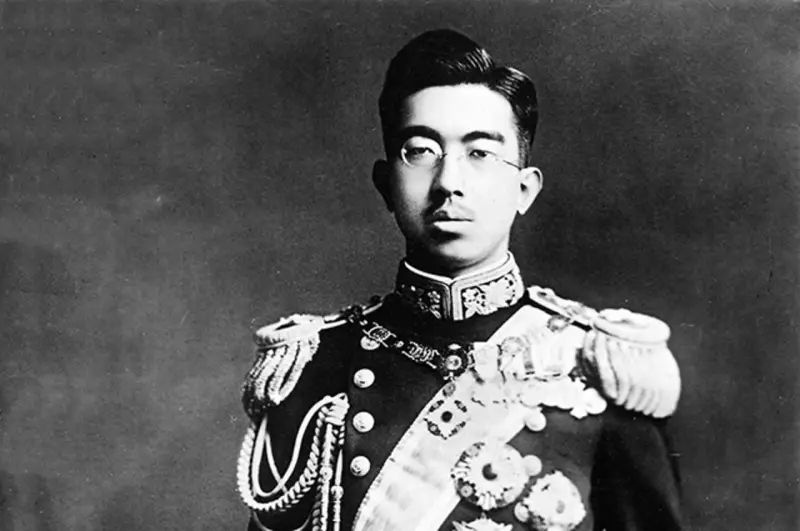
Hirohito. Under him, Japan experienced the Great Depression, invaded China and entered World War II
The former did not want to see subjects of the Mikado in the Celestial Empire, especially near the Chinese Eastern Railway, the latter intended to plunder the country without their help.
Tokyo did not agree with either one or the other, which only brought closer the appearance of the SB in the skies over Taiwan, and three years later the B5N2 over Pearl Harbor. But we’ll talk about this in more detail in the next article.
To be continued ...
Использованная литература:
Bezrukov D. A. Washington Conference on Limiting Naval Arms as a Factor in the Emergence of Potential Controversies in the Asia-Pacific Region
Popov G. G. Japan on the way to participation in World War II: the first steps of economic mobilization and the Chinese question // Historical and economic studies. – 2017.
Information